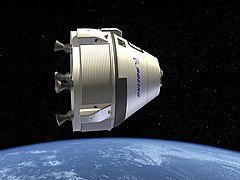Commercial Crew Program (2010-present)
The Commercial Crew Development (CCDev) program was initiated in 2010 with the purpose of creating American commercially operated crewed spacecraft capable of delivering at least four crew members to the ISS, staying docked for 180 days and then returning them back to Earth.[84] It is hoped that these vehicles could also transport non-NASA customers to private space stations such those planned by Bigelow Aerospace.[85] Like COTS, CCDev is also a fixed price milestone-based developmental program that requires some private investment.[77]
 In 2010, NASA announced the winners of the first phase of the program, a total of $50 million was divided among five American companies to foster research and development into human spaceflight concepts and technologies in the private sector. In 2011, the winners of the second phase of the program were announced, $270 million was divided among four companies.[86] In 2012, the winners of the third phase of the program were announced, NASA provided $1.1 billion divided among three companies to further develop their crew transportation systems.[87] In 2014, the winners of the final round were announced.[88] SpaceX's Dragon V2 (planned to be launched on a Falcon 9 v1.1) received a contract valued up to $2.6 billion and Boeing's CST-100 (to be launched on an Atlas V) received a contract valued up to $4.2 billion.[89] NASA expects these vehicles to begin transporting humans to the ISS in 2017.[89
In 2010, NASA announced the winners of the first phase of the program, a total of $50 million was divided among five American companies to foster research and development into human spaceflight concepts and technologies in the private sector. In 2011, the winners of the second phase of the program were announced, $270 million was divided among four companies.[86] In 2012, the winners of the third phase of the program were announced, NASA provided $1.1 billion divided among three companies to further develop their crew transportation systems.[87] In 2014, the winners of the final round were announced.[88] SpaceX's Dragon V2 (planned to be launched on a Falcon 9 v1.1) received a contract valued up to $2.6 billion and Boeing's CST-100 (to be launched on an Atlas V) received a contract valued up to $4.2 billion.[89] NASA expects these vehicles to begin transporting humans to the ISS in 2017.[89
https://en.wikipedia.org
See this video is really nice
https://www.youtube.com

I like a lot
ResponderEliminar